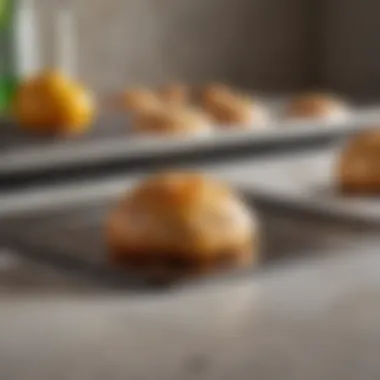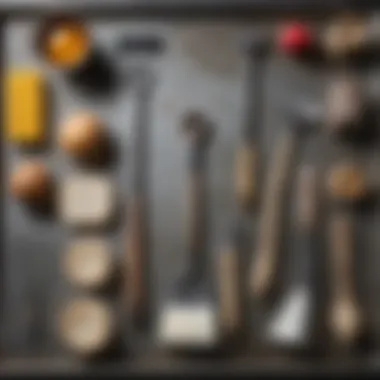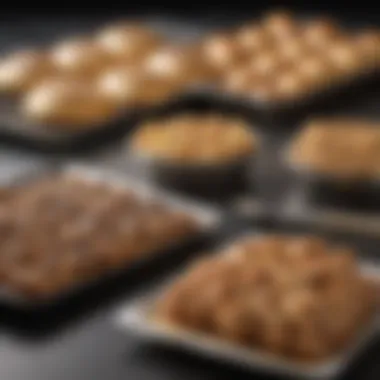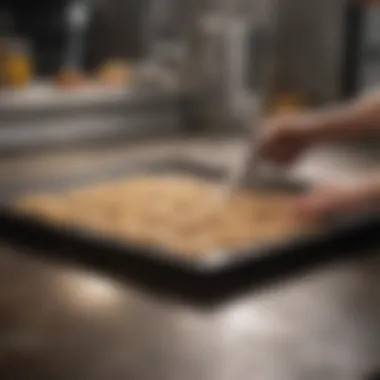Ultimate Techniques for Cleaning Baking Sheets


Intro
Cleaning a dirty baking sheet can seem like a daunting task. However, with the right approach, it can be more manageable than one might think. Over time, baking sheets accumulate grease, residue, and stains that can affect their appearance and performance. This guide aims to provide detailed methods for cleaning and maintaining these essential cooking tools. From routine care to advanced cleaning techniques, readers will find practical tips tailored for every cook—whether you are a novice learning the ropes or an experienced chef refining your skills.
Understanding the significance of a clean baking sheet goes beyond aesthetics. It plays a crucial role in ensuring your food bakes evenly and does not pick up off-flavors from old grime. By equipping yourself with knowledge and strategies for maintaining cleanliness, you can prolong the life of your baking sheets and enhance your cooking experiences.
In this guide, we will cover various topics, including effective cleaning methods, tips for regular maintenance, and insights on how to prevent future buildup. Understanding these aspects will help you restore your baking sheets to their original shine and keep them functional for years to come.
Understanding the Importance of a Clean Baking Sheet
A clean baking sheet is essential in any kitchen. It significantly affects the cooking results and the overall health of the ingredients. While some may overlook this aspect of kitchen maintenance, understanding its importance can lead to better culinary outcomes and a more enjoyable cooking experience.
Impact on Flavor and Presentation
The condition of a baking sheet can influence the flavor and presentation of food. A dirty baking sheet may retain flavors from previous meals, which can transfer to newly baked items. For instance, if you used a sheet to roast fish, and it was not cleaned properly, the next batch of cookies might pick up an undesirable fishy taste.
Moreover, unclean sheets can compromise the appearance of the baked goods. Stains and burnt remnants can cause uneven baking or lead to unsightly discoloration on your cookies or pastries. This can be particularly important when presenting dishes to guests. A well-maintained baking sheet contributes to an aesthetically pleasing dish, enhancing the overall dining experience.
Health Considerations
There are also critical health considerations to keep in mind when it comes to cleanliness. Baking sheets can harbor bacteria if not cleaned properly. Residues from food, particularly those containing fats, can provide a breeding ground for microorganisms.
Using a baking sheet that is not adequately sanitized may increase the risk of foodborne illnesses. It's advisable to follow proper cleaning practices to eliminate any harmful bacteria and ensure a safe cooking environment. This is especially relevant in households that prepare food for children or those with compromised immune systems.
Identifying Different Types of Baking Sheets
Understanding the different types of baking sheets is crucial for effective cleaning. Each type has unique properties that influence how it should be maintained and the cleaning methods that are most suitable. Knowledge of the material will help in choosing the right tools and solutions for cleaning, ensuring that you do not damage your baking sheets while trying to restore their pristine state.
This section covers three main types of baking sheets: aluminum, non-stick, and insulated. Knowing these differences can elevate both your cleaning practices and your cooking outcomes.
Aluminum Baking Sheets
Aluminum baking sheets are popular for their excellent heat conductivity. They heat up quickly and distribute heat evenly, resulting in perfectly baked goods. However, aluminum is prone to staining and showing marks from food. Over time, this can affect the visual appeal of the baking sheets.
When cleaning aluminum sheets, it's important to avoid using abrasive scrubbers as they may scratch the surface. Instead, opt for softer materials like sponges or cloths. Simple solutions such as baking soda and water can effectively tackle stains without compromising the sheet's integrity.
Non-Stick Baking Sheets
Non-stick baking sheets are beloved for their convenience. They require less oil and make removing baked goods a breeze. The coating, usually Teflon or a similar substance, is sensitive and can be damaged by harsh cleaning methods.
To maintain non-stick baking sheets, use non-abrasive cleaners and soft scrubbers. Dish soap mixed with warm water usually suffices. It’s also advisable to minimize exposure to high temperatures, which can degrade the non-stick surface over time.
Insulated Baking Sheets
Insulated baking sheets have a unique design that provides an extra layer of insulation, promoting even baking and preventing over-browning. They are typically heavier and can be more challenging to clean due to their size and structure.
When dealing with insulated sheets, it’s essential to follow the manufacturer's cleaning guidelines, as they may have specific recommendations. A gentle approach is usually preferable, using soft cloths and mild detergents. Avoid immersing these sheets in water for long periods, as this can trap moisture in the insulation layer.
In summary, while all baking sheets serve a similar purpose, their material and design greatly influence their performance and care requirements. Knowing how to clean and maintain each type can extend their lifespan and ensure they remain in optimal condition for your culinary endeavors.
Assessing the Level of Cleanliness Required
Understanding the level of cleanliness needed for your baking sheet is crucial. This not only determines how effectively you can restore it but also affects how long the baking sheet lasts. Different cooking scenarios demand different levels of attention. For instance, a sheet used once for roasting vegetables might only require routine maintenance, while one that baked sticky cinnamon rolls might need a more rigorous cleaning approach. Recognizing when a sheet is ready for cleaning, and what kind of cleaning it needs, can save both time and effort.


Routine Cleaning Versus Deep Cleaning
Routine cleaning is an everyday responsibility that involves quick, simple methods to maintain the baking sheet in good condition. This includes wiping it down after use or soaking it briefly to remove minor stains. This step is essential for preventing the build-up of grease and food particles that can lead to staining or damage over time.
On the other hand, deep cleaning requires a greater investment of time and effort. This process is typically necessary when there is significant residue or stains present. A deep clean might involve soaking the sheet in a solution of hot water and dish soap or using baking soda for more stubborn spots. Being able to identify when a deep clean is required can dramatically enhance the longevity and performance of a baking sheet.
Signs of Build-Up
There are several signals that your baking sheet may require more than routine care:
- Discoloration: If your sheet appears darker or stained, this is often the first indicator that it needs cleaning.
- Sticky Residue: A greasy or sticky feel after washing indicates that the baking sheet may not be clean enough.
- Burnt Food Residues: If there are chunks of burnt food stuck to the surface, a deep clean is unavoidable.
"Prolonged neglect can lead to permanent damage, making it essential to recognize these signs early."
By staying attuned to the condition of your baking sheet, you can decide when to perform routine cleaning or opt for a deep cleaning session. This understanding is not merely about maintaining aesthetics; it directly impacts food preparation and ultimately, your culinary success.
Essential Cleaning Supplies
In the realm of maintaining a clean baking sheet, the right supplies are paramount. Selecting the suitable cleaning materials not only simplifies the cleaning process but also enhances the effectiveness of the techniques employed. Without proper supplies, one may find themselves struggling with stubborn stains or greasy residues, ultimately diminishing the performance of their baking sheets.
Understanding the properties and functions of different cleaning tools and solutions is crucial for culinary enthusiasts. Each material or solution holds its unique advantages and can significantly alter the outcome of your cleaning efforts. Whether addressing routine maintenance or more intense cleaning needs, the right cleaning supplies play a vital role.
Choosing the Right Scrubbers
Selecting appropriate scrubbers is essential for effective cleaning. It is important to choose scrubbers that match the type of baking sheet you own. For example, softer scrubbers are recommended for non-stick surfaces. They prevent scratching and preserve the coating, ensuring longevity. On the other hand, firmer scrubbers can be used on stainless steel sheets where tougher stains might require extra scrubbing power.
Using the right scrubber is not just about effectiveness but also about longevity of your equipment. Repeated use of inappropriate scrubbers can lead to quicker wear and tear on your baking sheets, increasing the need for replacements. Therefore, investing in quality scrubbers designed for specific types of sheets is a wise decision.
Effective Cleaning Solutions
Baking Soda
Baking soda is perhaps one of the most versatile cleaning solutions you can employ. It acts as a mild abrasive that can lift stains without damaging surfaces. A paste of baking soda and water can tackle baked-on grime effectively. The alkaline nature of baking soda helps to dissolve grease and neutralizes odors. It is a popular choice for those who prefer natural cleaning methods, making it not only beneficial but also safe.
Additionally, baking soda is an economical choice. A small amount goes a long way when mixed with water, and it can be applied directly to specific areas of concern. However, its effectiveness may be limited against tougher, baked-on stains, requiring additional scrubbing effort.
Vinegar
Vinegar serves as an excellent partner to baking soda, especially when faced with persistent stains. Its acidic nature makes it effective in cutting through grease and grime. Combining vinegar with baking soda creates a powerful cleaning reaction, helping to lift stubborn debris from your sheets. Beyond its effectiveness, vinegar is a great eco-friendly alternative to harsh chemical cleaners.
Although vinegar is effective for many stains, it is important to note that it may not work on all materials. For example, prolonged exposure to vinegar can erode certain finishes and coatings. Therefore, one should use it judiciously, especially on fine non-stick surfaces.
Dish soap
Dish soap is another staple in many kitchens. Its primary use in cutting grease makes it highly effective for cleaning baking sheets that have been used for oily foods. It can easily be mixed with warm water to create a soapy solution that loosens tough residues. An important characteristic of dish soap is its ability to emulsify oils, making it easier to wipe away since oils mix better with soap than with plain water.
The ease of use and availability of dish soap make it a common choice. However, it may not be sufficient on its own for heavy-duty cleaning. Often, it performs best when combined with another cleaning agent, like baking soda or vinegar, particularly for tougher stains.
Commercial Cleaners
Commercial cleaners are formulated with specific ingredients designed to tackle tough jobs. They often contain strong chemicals that can penetrate stains and grime more effectively than traditional household items. This can lead to faster and more efficient cleaning results, making them suitable for those who require thorough cleaning in less time.
While they provide benefits, it is essential to approach commercial cleaners with caution. Many can contain harsh chemicals that may damage certain baking sheets or pose health risks if not used properly. Always read labels carefully and consider the material of your baking sheets before applying these products.


Each of these cleaning solutions comes with its unique features, and understanding them allows for informed decision-making in the cleaning process. With the right supplies, maintaining a clean baking sheet can become a manageable task.
Step-by-Step Cleaning Techniques
Cleaning a dirty baking sheet effectively requires a systematic approach. This section provides detailed techniques tailored to different levels of cleaning needs, ensuring that you can maintain your culinary tools in optimal condition. By understanding these techniques, you not only prolong the life of your baking sheets but also enhance your food preparation experience.
For Routine Maintenance
Routine maintenance is vital for keeping baking sheets in good condition. Simple practices can prevent the build-up of grease and food residue, making deep cleaning less frequent. After each use, a quick clean can save considerable time down the line. Start by washing the sheet with hot water and dish soap. Use a soft sponge to wipe off any residues.
- Immediate cleaning: Clean your sheets right after use while they are still warm. This makes it easier to remove stuck-on food.
- Drying: Always dry your baking sheets thoroughly after washing. Leaving them wet can cause warping over time, especially in aluminum sheets.
- Storage: Store your baking sheets in a cool, dry place. Avoid stacking them together without a protective layer, as this can cause scratches and marks.
For Stubborn Stains
Stubborn stains may require more intensive techniques. If you notice burnt-on food or discoloration, do not panic. There are several effective methods to treat these persistent issues. One popular method involves using baking soda as a gentle abrasive.
- Baking Soda Paste: Mix baking soda with a small amount of water to create a paste. Apply this paste to the stained areas and let it sit for at least 15-30 minutes.
- Scrubbing: Use a non-abrasive scrubber to gently work on the stains. Avoid metal scrubbers, as they can scratch surfaces.
- Rinsing: Rinse thoroughly with hot water to remove any residue from the paste.
Another effective solution involves vinegar. Spraying vinegar on the baking sheet can help to cut through grease and grime. Combining vinegar with baking soda creates a fizzy reaction that aids in breaking down tough stains.
Using the Oven for Cleaning
An unconventional but effective method to clean baking sheets is utilizing the oven itself. This method leverages heat to combat stubborn debris.
- Preheat: Set your oven to a low temperature, around 200°F (93°C).
- Place the Sheet: Put the dirty baking sheets on a middle rack. Let them heat for about 15-20 minutes.
- Cool and Scrub: Once heated, remove the sheets carefully. While they are still warm, use a damp cloth or sponge to wipe away loosened debris.
This technique is particularly helpful for tasks where heavy-duty cleaning is needed without excessive scrubbing.
Incorporating these step-by-step cleaning techniques will help maintain the performance and appearance of your baking sheets. With proper care, they can serve you well for years, making every baking experience more enjoyable.
Preventative Measures to Maintain Cleanliness
Keeping a baking sheet clean requires more than just occasional scrubbing. It necessitates a proactive approach. Implementing preventative measures can help maintain the cleanliness of your baking sheets, which is key to prolonging their life and ensuring optimal cooking. This section discusses how foresight in using your baking sheets can make a significant difference in cleanup time and overall kitchen hygiene.
Use of Parchment Paper
One of the simplest and most effective ways to prevent staining on baking sheets is by using parchment paper. This non-stick surface offers several benefits:
- Ease of Cleanup: Parchment paper acts as a barrier, ensuring that food does not adhere to the sheet. After baking, you can simply lift the paper away, and most residue goes with it.
- Preservation of Finish: Using parchment paper can help keep your baking sheet looking new. It prevents the buildup of grease and grime that can turn into tough stains.
- Versatile and Convenient: It works well for a range of cooking methods, including roasting and baking, making it a versatile tool in any kitchen.
Proper Cooling Techniques
Another crucial aspect of maintaining cleanliness is understanding cooling techniques. How you handle your baking sheets post-use can influence their longevity.
- Avoid Cold Shock: Never place a hot baking sheet on a cold surface. Sudden temperature changes can warp the sheet, leading to uneven cooking in the future. This warping can also create crevices that trap food particles, making cleanup harder.
- Use a Wire Rack: Allow baked goods to cool on a wire rack rather than on the baking sheet itself. This preserves the sheet's surface and allows for better air circulation around the food.
Proper care of your baking sheets includes not only cleaning them but also being mindful of how they are used and cooled.
Through these preventative measures, users can effectively enhance the hygiene and longevity of their baking sheets. Implementing such practices creates a smoother baking experience, saving both time and effort when it comes to cleaning.
What to Avoid When Cleaning
When it comes to cleaning baking sheets, choosing the right methods and tools is essential. Not all cleaning products or techniques are suitable. Knowledge of what to avoid can prevent damage to your baking sheets and ensure their longevity. This section highlights two significant areas to steer clear of: harsh chemicals and metal scrubbers on non-stick surfaces.


Harsh Chemicals
Using harsh chemicals can pose several risks. Many commercial cleaning products contain strong abrasives and corrosive ingredients. These substances can ruin the finish of your baking sheets, particularly those that are non-stick. Over time, the integrity of the surface can break down, leading to food sticking and increased difficulty in cleaning.
Additionally, these chemicals can leave behind residues, potentially contaminating future meals. It is important to protect your health by avoiding exposure to toxic substances. Opt for milder alternatives, as they tend to be safer and more effective in the long run.
Using baking soda and vinegar can be an effective, non-toxic approach to cleaning.
When selecting cleaning supplies, always read labels to know what ingredients you are using. Sometimes, methods as simple as warm water with dish soap can achieve satisfactory results without resorting to harsh chemicals.
Metal Scrubbers on Non-Stick Sheets
Using metal scrubbers on non-stick baking sheets is another mistake many make. While these scrubbers are effective at lifting stubborn grime on other surfaces, they can severely damage non-stick coatings. The abrasive fibers can scratch and wear down the non-stick layer, compromising its effectiveness. Once the coating is damaged, you might find that food sticks more and cleaning becomes increasingly difficult.
Instead of metal scrubbers, consider softer alternatives like sponges or cloths. These options allow for a thorough clean without risking the surface of your baking sheets. For particularly stubborn stains, a baking soda paste or white vinegar can provide a gentle yet effective cleaning solution.
Choosing the right cleaning techniques and tools can prolong the life of your baking sheets. Avoiding harsh chemicals and metal scrubbers ensures that your baking sheets remain in optimal condition, providing you with the best cooking experience possible.
Demystifying Common Myths
Understanding the common myths surrounding the cleaning of baking sheets is crucial for any culinary enthusiast. Misinformation can lead to ineffective cleaning methods and potential damage to valuable kitchen tools. Identifying these myths not only helps in choosing the right cleaning strategy but also ensures longevity and safety of the baking sheets. Some practices that may seem harmless could actually be counterproductive. Furthermore, debunking these myths can instill a sense of confidence in users when they approach the task of cleaning.
Myth of the Self-Cleaning Oven
A prevalent misconception is that utilizing a self-cleaning oven can effectively clean baking sheets. This belief stems from the idea that the extreme heat generated during the self-clean cycle will dissolve all grime and residue on the baking sheets. However, this is not entirely accurate. While a self-cleaning oven can indeed eliminate food particles from the oven itself, the reality is that placing a baking sheet inside during such a cycle can lead to warping or other damage due to intense heat exposure.
Moreover, the vast majority of baking sheets are not designed to withstand the high temperatures associated with self-clean cycles. Instead of cleaning them, the process may accelerate wear and tear.
It is always advisable to clean baking sheets manually with proper techniques rather than relying solely on self-cleaning ovens.
To maintain the integrity of your baking sheets, it’s better to engage in regular cleaning practices. This will ensure that they remain functional and safe for use in future baking tasks.
Over-Reliance on Dishwashers
Another common myth is the assumption that dishwashers can adequately clean baking sheets, particularly those made from non-stick materials. While dishwashing might seem like a convenient option, it often does not provide a thorough clean. Dishwashers tend to not dissolve stubborn stains and burnt-on foods that can cling to baking sheets.
Additionally, the heat and moisture in the dishwasher can adversely affect certain materials over time. For instance, non-stick surfaces may lose their coating if washed frequently in high temperatures.
Many baking sheets require specific attention to remove residues effectively. Here are some reasons to reconsider the reliance on dishwashers for these essential kitchen tools:
- Incomplete Cleaning: Dishwashers might miss areas, especially in textured or crinkled surfaces.
- Loss of Coating: Prolonged exposure to hot water can degrade non-stick surfaces.
- Warping Risk: Hot water and drying cycles may cause bending or twisting, especially in lightweight baking sheets.
Instead of relying on a machine, manual cleaning allows for targeted techniques that ensure your baking sheets are thoroughly cleaned without risking damage. Regular hand washing with the appropriate tools guarantees better care and improved performance over time.
Culmination and Final Thoughts
A clean baking sheet is essential for both culinary performance and presentation. This guide has examined various aspects of cleaning baking sheets, emphasizing the importance of establishing a cleaning routine. Consistent maintenance prevents buildup and keeps baking sheets in optimal condition.
Establishing a Routine
Creating a cleaning routine takes minimal effort but offers significant rewards. Regular cleaning after each use prevents stubborn stains from forming. For routine maintenance, a simple wash with dish soap and warm water suffices. Allowing sheets to soak for a few minutes can also help in loosening stuck-on food. Additionally, it can prove helpful to have cleaning tools, such as sponges and non-abrasive scrubbers, readily available.
To keep things manageable, consider designating specific days or times for deep cleaning. For example, after intensive baking sessions, a thorough clean can be scheduled. Involving all household members can turn the task into a collective responsibility, promoting a communal approach to maintaining kitchen tools.
The Benefits of Maintenance
Regular maintenance offers multiple benefits. Firstly, it enhances the longevity of your baking sheets, saving money on replacements. Avoiding harsh chemicals further contributes to the overall healthiness of your cooking environment, as chemical residues can transfer to food. A clean sheet allows for more even heat distribution during baking, improving the quality of baked goods. Furthermore, pristine baking sheets reflect a level of care and professionalism in the kitchen, especially for culinary enthusiasts who may serve guests or family.
In summary, investing time in establishing a cleaning routine and understanding the benefits of proper maintenance will enhance your cooking experience. With maintained baking sheets, you ensure every baking endeavor is successful and enjoyable.







